#the case of the maligned mobster
Explore tagged Tumblr posts
Text

“Della,” Perry pleaded, “I'm serious.”
“So am I,” she informed him in a tone of voice that brooked no argument. “Now, answer the question, counselor: why did you become a lawyer?”
“I became a lawyer to help people, to protect them; to defend the integrity of the law and ensure that it supports justice for everyone, not just those with money and influence.”
I couldn't get over The Case of the Maligned Mobster so I had to write a fic about it. Enjoy.
#perry mason#della street#perry mason/della street#the case of the maligned mobster#perry mason fic#laura writes#everything about this episode haunted me#the way perry spent the whole thing asking for della's approval of representing sorrento#i just couldn't
2 notes
·
View notes
Note
I was thinking instead of all the minor mobster characters, a better TMNT 1987 could make them all these mafioso, Don Turteli, promoted to regular. Don Turteli would eventually get turned into a turtle mutant, thus coinciding with Playmates releasing an action figure of Turteli.
Do you think that'd work better? I'm trying to think of something for the generic mad scientists too?
I think that if you had a smaller pool of writers during seasons three through five working on fewer episodes, with a stronger focus on coherent storytelling, then yeah, you could absolutely consolidate all of TMNT's mobsters into one, and Turtelli feels like the obvious candidate. You could mutate him into a villainous gangster Turtle, either from the outset or later on. Certainly that kind of character would be more marketable, more appealing to kids, more likely to work as a potential toy in the Playmates line, all that fun stuff. But the key thing is that he would need to be presented as a true threat to the Turtles, ideally in a way that would differentiate him from Shredder and which would be compelling.
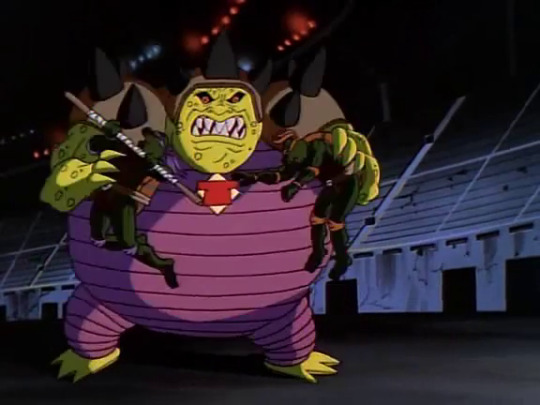
There are a few characters throughout the show's run who are able to apply pressure and challenge the Turtles in ways different to Shredder, but they tend to be guys with some kind of money or institutional power (think AJ Howard or J. Gordon Hungerdunger, who each have money/clout but who aren't much to look at, and who I doubt would shift many units as action figures). IMO, the best example of what could be done in terms of introducing a second big bad is actually from the much maligned Red Sky era, and it's Titanus. Here we have a guy who ticks all the boxes: an actual crime boss, in this case from a far-off future, who commands a group of generally interesting mutants, has a compelling look that works when placed next to other characters in TMNT, who can go toe-to-toe with the Turtles but also has clout via his H.A.V.O.C. group. If we're talking about just having one strong recurring mutant villain in the show from S3 onwards, someone who isn't Shredder but could be almost as compelling, I think Titanus is the blueprint, it'd just be a case of implementing something like that several years earlier.
#teenage mutant ninja turtles#tmnt#tmnt 1987#turtlethon#J. Gordon Hungerdunger is extremely fun to say
4 notes
·
View notes
Photo
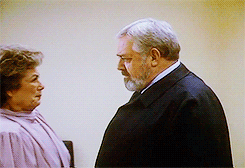
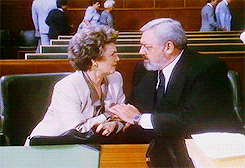
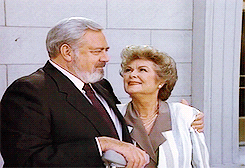
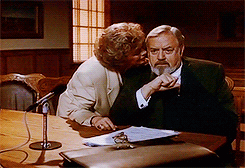
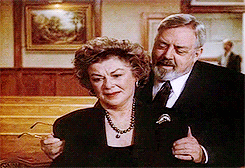
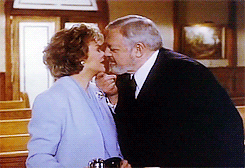
“The affection between the two performers was obvious. Raymond told me over lunch one day that he planned to end the series of movies with one in which Mason and Della finally got married. The films began to include genuine expressions of love between the characters, even a kiss or two (the original series had been much more coy about what was an obvious long ongoing relationship between boss and secretary).” - Max Allan Collins
#Perry Mason#Raymond Burr#Barbara Hale#Max Allan Collins#Della Street#gif#cue Whitney Houston's 'Didn't We Almost Have It All'#Perry Mason Returns#The Case of the Telltale Talk Show Host#The Case of the Reckless Romeo#The Case of the Maligned Mobster#The Case of the Murdered Madam
209 notes
·
View notes
Photo
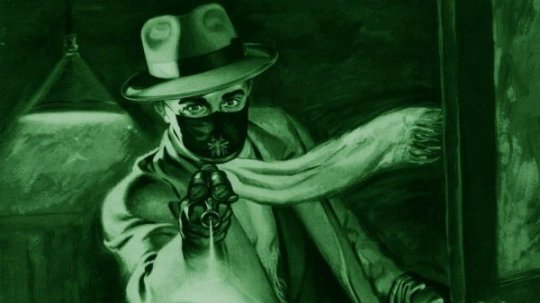
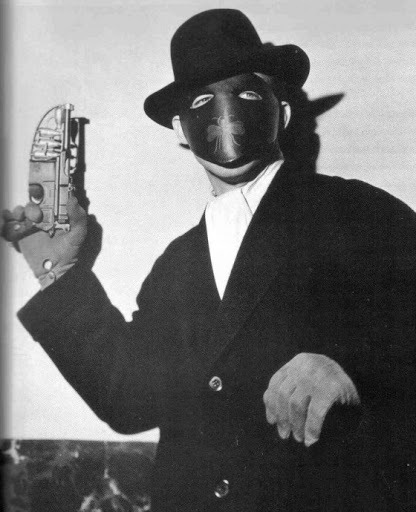
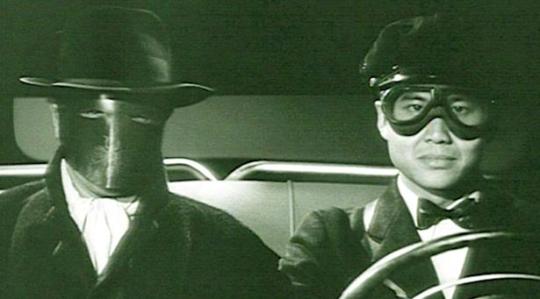
“He hunts the biggest of all game - public enemies who try to destroy our America!
“With his faithful valet Kato, Britt Reid - daring young publisher - matches wits with racketeers and saboteurs, risking his life so criminals and enemy spies may feel the weight of the law by the sting of The Green Hornet!”
Before Bruce Wayne became a bat to terrify villains, another wealthy playboy donned a mask by night in a war against crime. Crusading newspaper publisher Britt Reid led a fight against graft and corruption everyday in the Daily Sentinel, but he found there were limits to what he could accomplish with strongly worded editorials. His zeal for justice led him to a new life as The Green Hornet, a masked vigilante who pursued the political bosses and mobsters beyond the reach of the police. Aided by his valet Kato, Reid took to the streets in the “Black Beauty,” a sleek, super-powered sedan, and made his nightly hunt for criminals of all stripes. One of radio’s most popular heroes, the Hornet has continued to entertain ever since his debut on January 31, 1936.
The Hornet sprang from the creative pool at WXYZ, the Detroit radio station that just a few years earlier introduced audiences to “the daring and resourceful masked rider of the plains,” The Lone Ranger. Producer George W. Trendle wanted a companion show for The Lone Ranger, one that would feature a hero standing up to lawlessness and corruption in politics and the circles of power. Trendle worked with writer Fran Striker and director James Jewell, two of the creative minds behind The Lone Ranger. Eventually, they developed the concept of Britt Reid, the crusading publisher, and Kato - his loyal valet - as a sort of Lone Ranger and Tonto for the modern era. Instead of powerful horses, this hero would travel in the “Black Beauty,” a souped-up, sleek sedan. He traded the silver bullets of the old west for a high-tech gas gun that didn’t kill villains; it only knocked them out.
One tie to the earlier series was Britt Reid’s family tree. His father, Dan, had been the nephew of the Lone Ranger introduced on the earlier program (where he was played by future Inside the Actors’ Studio host James Lipton). The elder Reid eventually discovered his son’s dual identity, and (with the William Tell Overture playing in the background) he told his son about his family’s history of fighting for law and order.
The series premiered in 1936 and ran until 1952. Al Hodge (later the star of TV’s Captain Video) played Britt Reid and the Hornet until 1943. His performance was interrupted by military service, but he returned in 1945. Other actors (Donovan Faust, Bob Hall, and Jack McCarthy) played the character, but Hodge is the most famous of the radio Hornets. Fran Striker created a rich universe of characters that worked alongside Britt Reid. One of the more colorful supporting characters was Mike Axford, an ex-cop initially introduced as Britt Reid’s bodyguard but who later became a police reporter for the Sentinel. Axford used his old connections on the force to get tips and usually accompanied the cops on raids and pursuits. Axford was played by Jim Irwin from 1936 until his death in 1938. Gil Shea assumed the role and played the blustery Irishman for the duration of the show’s run. Axford was a bit of a bumbler, and he was prone to excited exclamations. “Saints preserve us!” was a favorite whenever he was talking about the dreaded “Haarnet.”
Lenore Allman (sister of director James Jewell) played Lenore Case, Britt Reid’s secretary. Late in the run, Reid took Miss Case into his confidence and shared his true identity with her. Jack Petruzzi played Ed Lowry, a hot-headed Sentinel reporter who occasionally landed in trouble due to his impulsive desire to run down a story. Kato was played by several actors, including Tokutaro Hayashi (billed as “Raymond Toyo”), Rollon Parker, and Michael Tolan.
On radio, the Green Hornet and Kato battled the corrupt and the crooked - everyone from slum lords to shady city councilmen to the mob. When the show first premiered, the opening narration announced that the Hornet hunted “the biggest of all game – public enemies that even the G-Men cannot reach.” This didn’t sit well with FBI Director J. Edgar Hoover, as no crook was beyond the reach of the Bureau. In response, the narration was changed to “public enemies who try to destroy our America.” As America entered World War II, the Hornet frequently did battle with spies and saboteurs on the home front. One of his greatest recurring enemies was Oliver Perry, an unscrupulous private detective who came close on several occasions to confirming his suspicions that Britt Reid was the Green Hornet.
Like his vigilante ancestor, the Green Hornet eventually made his way to television. Van Williams starred as Britt Reid in a 1966-67 ABC television series. Kato was played by a young Bruce Lee in his first American screen role. The Green Hornet was produced by William Dozier, who brought Batman to TV with great success just a few months earlier. In fact, he had the Hornet and Kato pay a visit to Gotham City in three episodes of Batman, including a memorable two-parter where the heroes teamed up to battle the same villain. Unfortunately, whereas Batman took America by storm, The Green Hornet failed to click and it left the air after a single season. Most recently, Seth Rogen brought the character back to the big screen in a widely maligned 2011 film. The tepid reception he received suggested it would be a long while before we ever sawthe Hornet on screen again. However, in late 2016, rumblings were heard about director Gavin O’Connor (The Accountant) developing a new cinematic adventure of Britt Reid. Whatever happens with the Hornet’s big screen fortunes, we’re lucky that his exploits from the Golden Age of Radio can still be heard and enjoyed today.
11 notes
·
View notes
Text
Me introducing the Batfamily: "This is Dick Grayson—Robin the first, later Nightwing, Renegade, Nightwing, Agent 37??, Nightwing. My golden child, heart of the DC universe. Poster child for Eldest Daughter Syndrome, after an adolescence spent trying to live up to the exacting expectations of an emotionally constipated parental figure while being made responsible for both his emotional health and safety along with everyone else's. Veers between an indefatigable sense of humour buoyed by terrible puns, and high functioning depression. He is the big brother everyone idolizes, a hypercompetent and responsible human being who looks out for everyone except himself, a perfect balance of Superman's light and hope and Batman's dark brooding (although the scales keep tipping this way and that tbh). The Batfamily's Golden Boy's career has been marred only by his dire sense of fashion throughout his young adulthood (currently rocking the sexiest superhero outfit will never erase the scars of green Robin panties and the Discowing mullet), emotional impermanence in his relationships, grossly overestimating his own capacity to do everything at once, and attempting to live on cereal, as well as every so often absolutely blowing his lid and fulfilling his asshole quota all at once. The greatest acrobat in the world, he is uniquely characterized by 1) his on-and-off relationship with assorted redheads and gravity, 2) everyone and their mother being compelled to remark on how pretty he is even in a mask, and 3) being the owner of the Damn Fine, the world's finest posterior (they took a poll).
"This is Jason Todd—Robin II, later Red Hood. A brick shithouse of stabby shooty snark that rattles the fourth wall, he is a proponent of murder and blowing shit up in the name of social justice. Both his morals and aesthetic combines utilitarianism with being a melodramatic asshole (distinctive red full face helmet with a domino mask underneath, combat boots, leather jacket of manpain). Has a gun fetish due to his unhealthy obsession with making the pathologically gunphobic Batman eat every last bit of dick, but is also pro-gun control (he controls all the guns).
Driven away from his sidekick career at the age of fifteen by Bruce's paranoia that he may have killed a repeat offender rapist, he was then betrayed by his birth mother to the Joker who beat him with a crowbar and blew him up. Later was resurrected via cosmic hissy fit but had to dig his way out of his own grave and wandered the streets brain-damaged until Batman's walking Oriental fetish Talia Al Ghul, daughter of the (sort of) immortal Ra's Al Ghul, found him. She dunked him in the life-rejuvenating Lazarus Pit, which healed his faculties but left him with a case of PTSD from hell. Came back to Gotham to try and get his Bat-Dad to avenge him via reverse Hamlet scheme featuring a (now iconic) bag of decapitated mobster heads, but no dice. The 2011 reboot of the DC universe downgraded his reaction to this from "homicidal" to "salty".
He used to be a mop-headed little gremlin but Talia presumably fed him some Lazarus GMO beef along with the mad assassin skills because he became a bruiser almost taller than Bruce by the time he returned to Gotham. He's also the only reason why the whole fandom knows what a piebald streak is (trauma, but make it fashion) and his thunder thighs are legend. Fandom headcanons him as the world's angriest self-taught student of feminist and classical literature who will as likely kneecap you for maligning Jane Austen as for selling drugs to children.
(We reject the spurious allegations by Daniel, Morrison et al that he is remotely capable of child murder or of wearing a dildo helmet. He is guilty of many things but not being cringe. Mfer rocked a pimp cane with combat boots, for Christ's sake, why would he shoot kids or wear a suppository on his head.)
"This is Tim Drake, Robin the third, later Red Robin (not the fast food chain). He used to be the world's most well-adjusted latch-key kid, if you discount his stalking tendencies, but then his Mom died, his Dad died, his best boyfriends both died, his stepmom died, his city got nuked, his surrogate big brother Dick nearly died, his surrogate sister Cassandra "went crazy" and his adoptive Dad also (ostensibly) died. This happened nearly all within his sixteenth year of life, which gave rise to the meme "Tim Drake—Even His Houseplants Die". And then his aforementioned adored big brother fired him from being his sidekick in an epic dick move (pun intended for his crimes). As consequence, Timmy went from an adorable sunshiny kid who made friends with everyone to a brooding and manipulative asshole (affectionate), in the mold of Batman but with more dead parents.
The love child of a competence kink and a Bishounen, Tim's fashion sense veers between hobo I.T guy and sharp enough to kill you (except for that time with alternate universe Jason's cast-offs where he looked like knock-off Doctor Mid-Nite. Don't ask). The techie of the bunch, his investigative skills rival those of Batman's and served as the youngest CEO of Wayne Tech for a spell without graduating high school. Functions as some kind of caffeine vampire, hasn't slept in years, humanity too dependent on him to plan for every exigency. Has probably written a computer programme to remind him how to human. Very close to his now-adoptive sister Cassandra Cain and his now-legal brother Dick, whom he idolizes. Has a distrustful relationship with Jason whom he occasionally allies with, and a legendary rivalry with Damian Wayne (Bats's only biological whelp), who might be a prepubescent but also a hundred pounds of laser-focused murder grudge in a ten pound bag.
The only one of Bruce's adopted children to take his name (which again made no sense but Tim Drake-Wayne is a GQ motherfucker so fandom eventually rolled with it) Life challenges include subtextually being in love with his best friend Superboy while DC editorial desperately tries to make him straight¹, and fending off Ra's Al Ghul's creepy second-hand sexual fixation on him. Or on his genetic material. Who knows with that guy.
"This is Cassandra Cain, the third Batgirl and later Black Bat. Originator of the meme "looks like a cinnamon roll, is actually a cinnamon roll but will also kill you" except not because she has a no-kill rule more iron-clad than Batman's. Child of two of the DCU's most fucked up assassins, Cass was an experimental human murder weapon and not taught to speak but rather "read" body language. Ran away from her asshole Dad David Cain after her first and only kill at the age of eight traumatized the shit out of her. Wandered the world for years being a lethal cutie until she was taken under the wing of Barbara Gordon a.k.a Oracle. She had very limited ability to communicate with the world until a metahuman rearranged her neuroplasty to make her understand words, and accidentally precipitated a cascade of complications including baby's second existential crisis.
She is like a daughter and little sister to Barbara so it made little sense as to why Bruce was the one to adopt her, but she won his love and trust by proving it's his mission she idolizes more than anything. Arguably Bruce's favourite, being the only child who does not expect him to do any emotional labour other than emitting his brand of stoic, non-verbal Bat approval. Can easily kick his ass, your ass, everyone else's ass, her own ass. She'd be objectively terrifying if she wasn't possibly the most compassionate of them all, and also generally a cheeky, cocky little shit. Best friends include adoptive brother Tim Drake and Stephanie Brown.
(Yes, most of the tropes associated with Cass are kinda racist, considering she's half Asian.)
"My golden daughter Stephanie Brown, The Spoiler, Robin IV and Batgirl IV². Started her career by hitting Tim Drake in the face with a brick and becoming his most convincing heterosexual love interest to date. Joined the superhero game just to get revenge her abusive C List supervillain father, Cluemaster, and stayed in the game first because Batman kept telling her to get lost, and then later because she loved kicking ass in a homemade spandex outfit (the colour's EGGPLANT motherfucker).
This spunky little blonde weathered an abusive father, her mother's drug addiction, childhood emotional neglect, poverty, a teenage pregnancy, being a relationship with Tim Drake, Batman using her as a pawn to get Tim back by making her Robin, being fired from being Robin by Batman, accidentally starting a gang war in a bid to "prove" herself to Batman, almost dying after hours of grossly sexualized torture with a power drill, having her doctor fake her passing to keep her out of Batman's clutches (DR. LESLIE DEFENCE SQUAD FOREVER), and having writer Bill Willingham insist she was "never really Robin". She is the personification of hope and humour and sheer dogged perversity in a world that wanted her gone. Came back from the dead to bitchslap both her ex and Batman and became Batgirl under Oracle's watchful and (kind of) responsible mentorship.
Other notable relationships include Cass Cain her girlfriend best friend with whom she bonded over asshole Dads ("my Dad locked me in a closet when I was bad. What did your Dad do?" "Shot me." "LMAO I can't beat you at anything") and Damian Wayne, who calls her Fatgirl because he is ten and doesn't know how to deal with his crush. Other than Babs, she is possibly the only member in this fucked up family with a sense of perspective.
"This is my little murder kitten Damian Al Ghul Wayne, Robin V. The fact that he shares a name with the Anti-Christ was no accident because he was introduced as such. Bruce Wayne and Talia Al Ghul's only biological issue via test tube (we refuse to acknowledge his rapey Grant Morrison origins), the kid was Ra's eugenics wet dream designed as a vessel into which he could transfer his own consciousness in order to escape the end of his own body's Lazarus Pit warranty period. Talia decided to fuck that noise and sent the child to live with his Dad, whereupon he immediately tried to kill everybody else to claim his birthright because that's how ninja assassin cults and the Ottoman empire roll.
When Bruce temporarily died and Dick temporarily assumed the Bat mantle, he was also landed with a tiny ninja assassin brother with the social skills of a wet cat. So Dick gave him the Robin job (throwing his other brother under the bus) and after a rocky start, made great headway in making the child behave in some approximation of a human being.
Damian is adorably territorial of his big brother but absolutely hates Tim, apparently just on priciple. Dami dresses and behaves like the snotty little princeling he was raised as, and talks like a judgemental Cambridge dictionary, but is really a lonely child at heart who relates to animals better than humans. He has since collected a small menagerie which includes a rooster, Bat-Cow, Alfred the Cat, Titus the Great Dane and the enormous mythical beast Goliath who he saved when he was a cub that looked like a small Pokémon. Also made friends with a disabled street child named Colin Wilkes, a very Catholic cinnamon roll superhero fanboy who hulks out into a behemoth hero named Abuse. Other notable friendships include Stephanie Brown and Jon Kent, son of Superman.
"This is Barbara Gordon. She is the only Batkid to have graduated completely out of Bruce's sidekick programme and subsequently his bullshit. The first Batgirl is closest to Bruce in age and the beloved daughter of Batman's best friend, Commissioner Jim Gordon, she is more like a sister than a daughter to him. Barbara donned the Batgirl costume herself when she was seventeen after being turned down by the police academy for Reasons, and impressed Batman into mentoring her. She and Dick had a long running partnership and flirtation (her being much older than him) that very eventually matured into a romance in adulthood (that ended up such an unqualified storytelling clusterfuck that DC editorial swept the whole thing under the Rug Of Subtext until the reboot).
She had already decided to retire as Batgirl when the Joker shot her through the spine, paralyzing her for life. After a period of depression, she overcame this limitation with the help of a high-tech wheelchair, martial arts tutelage with Richard Dragon that accomodated her disability, and using her formidable intelligence to become Oracle, the communications mainframe of the JLA and international information broker (don't touch her wheelchair, bitch). She recruited Dinah Lance the Black Canary to found the Birds of Prey and later a whole slew of other lady superheroes, although it was Dinah who became her best friend (and soulmate).
Despite being a manipulative mastermind, her ruthless pragmatism and dark past, she avoids falling into the self-obsession and darkness that claims Bruce and his boys by leaning on her emotional support network, not having time for male nonsense and general dedication to acting like a human being.
"Alfred Pennyworth is effectively Bruce's father and grandfather to the batchildren although he is rarely directly acknowledged as such because idk classism and Bruce's manpain. He is the stereotypical stoic English butler who improbably gained custody of his employer's young son and enabled his unhealthy obsession with his parents murder because he was trapped between being a guardian and technically being on his charge's payroll (idk how any of this works, why didn't they just keep Uncle Phillip). He apparently used to work in Her Majesty's Secret Service, MI6 and Shakespearean theater before coming to America to become a butler, of all things. This worked to his advantage when Bruce decided to take up vigilanteism and also adopt a small army of children who would follow his lifestyle of beating the crap out of all their problems instead of going to therapy.
To Alfred's credit, he wanted more for his kids than this but he is only the butler and no one listens to him despite getting knocked out every time a supervillain breaks into the Batcave. He is a fan favourite³ and seen as the "Mom" of the batfamily but I have always had reservations about him because YOU COULD HAVE MADE THIS KID GO TO THERAPY BEFORE HE BECAME FIXATED ON BATS ALFRED. BUT YOU DID NOT. WHY.
"And finally we have Bruce Wayne, who everyone already knows about, having had 8372672 movies made about him by now. He's that bad boy I fell in love with when I was young and easily impressed by broody broken men before realizing he was kind of an asshole but then falling in love with his kids too much to ever leave. Bruce is at both his best and his worst when he is called to be a father to his children, perpetually torn between his love for them, his obsession with his mission and his own issues about supplanting their own biological parents.
"Does that answer your question?"
Fast food cashier: *eyes glazed* "So...you do want fries with that?"
1. This post was written before DC made Tim bisexual. But made him in love with Bernard instead. Further proof that they need to be killed with hammers.
2. note to nerds: Helena Bertinelli was Batgirl III during No Man's Land.
3. This is why DC killed him a short while after this post was written. Still has not been resurrected. Because they despise their readership and want us to suffer.
#mostly pre 52#i dont know much about duke thomas or harper row#didn't really follow new 52 or rebirth#and yes i cherry picked canon#i will not acknowledge bad writing#batman#batfamily#batkids#nightwing#robin#red robin#batgirl#oracle#red hood#black bat
99 notes
·
View notes
Photo

Perry Mason: The Case of the Maligned Mobster https://www.instagram.com/p/CFnny6gnfAcqcSC-t01p_FmpFLp5FbuhixT3-g0/?igshid=1xidekpg67k13
0 notes
Text
In The Irishman, Joe Pesci bosses over De Niro - hollywood
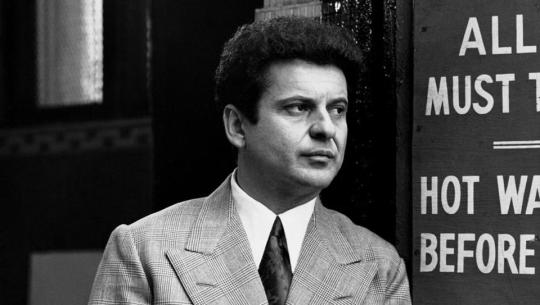
All through their acting lives, Robert De Niro has had better gigs, lines and dames than Joe Pesci. Especially in the films made by Martin Scorsese. So when Scorsese sent Pesci the script of The Irishman (released on Netflix recently) via De Niro who, according to the Hollywood grapevine, said, “Joe, you gotta”, he turned it down at least 40 times. Why he finally agreed to be Russell Bufalino is evident in the movie. For the first time, something else was being demanded of him.People like to see little Joe self-destruct and explode. His angry cinematic moments on YouTube have garnered a million views. Pesci, playing Tommy DeVito, brow-beats a fellow mobster (Ray Liotta in Goodfellas) in a restaurant…. Then there is the thrashing he gives actor Frank Vincent in the same movie, who in turn, thrashes him back in Casino…. Pesci’s slow-burn malignant buffoonery before he moves in for the kill, draws both chills and laughs. Always nasal, his high-pitched yap-yap is a signal that the plot will thicken and head towards a crisis. From that point onwards, it’s a cinch that a Joe Pesci film will leave someone dead; in many cases, Pesci included.
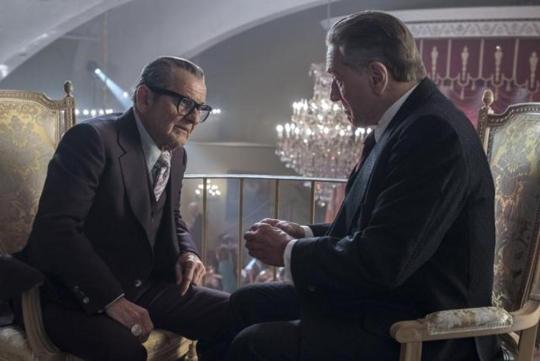
Role reversal: Mr Volatile, Joe Pesci (left), is Mr Gravitas in The Irishman. With Robert De Niro. ( Photo: Netflix ) But not this time. In The Irishman, the 76-year-old actor has a place at the high table of Philadelphia crime; he is Mister Gravitas gently nudging hitman Frank Sheeran, played by De Niro, to bump off inconvenient friends like trade union boss Jimmy Hoffa (Al Pacino) and foes. Here, De Niro waits for Pesci’s cues; in Pesci’s presence, he waits hat in hand. All roads, says Sheeran, lead back to boss Buffalino. Buffalino has Sheeran on a tight leash but keeps the pull gentle. There’s an exchange of sad and grim smiles on either side when Sheeran does a job on the side without letting the boss know or when Buffalino observes that Hoffa is getting “too emotional” and disturbing the status quo achieved between the union and the mafia. And towards the end of the film when Buffalino calls Sheeran “my kid” before handing him the Hoffa job, we know that a line has been crossed in cinematic history. This may or may not be Joe Pesci’s swan song but after The Irishman, he will no longer be seen as someone standing behind a De Niro. Or, an Al Pacino. As Pesci keeps saying in The Irishman, “It’s what it is.”
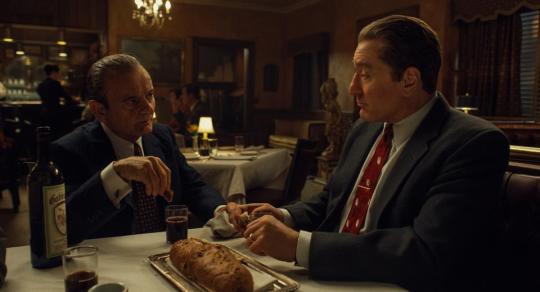
Dipping bread in wine, Russell Bufalino (Joe Pesci) gives instructions to Frank Sheeran (Robert De Niro). ( Photo: Netflix ) Joe Pesci’s best work was in the 1990s. The role of Russell Buffalino for which he came out of retirement is widely tipped to win an Oscar. Joey LaMotta: In Raging Bull (1980), Pesci plays boxing champ Jake LaMotta’s (De Niro) younger brother. He is the loyal and tough younger brother, the one person who can totally level with Jake but who is also his brother’s punching bag. Tommy DeVito: Pesci won the Best Supporting Actor playing the mobster with a hinge loose in Goodfellas (1991). DeVito is recalling past exploits with fellow gangsters at a restaurant when one of his listeners, says he’s funny. “Funny how?” asks Pesci quietly. The laughter at the table dies. Bernstein: Pesci plays Bernstein in The Public Eye (1992), based on the life of Weegee, the photographer of New York crime in the 1940s. “Pesci’s introspective, crablike performance gets under your skin,” said the Newsweek in praise.Vinny Gambini: In My Cousin Vinny (1992), Pesci plays the lead role for a change. Hot-tempered and witty, he plays a lawyer called in to defend his cousin in a murder case.Nicky Santoro: In Casino (1995), he plays the man with the money of an establishment run by his childhood friend Sam Ace Rothstein (De Niro). In the end, his greed and ambition get the better of him. Read the full article
1 note
·
View note
Text

Ugh, these two. Not only has Perry been shot (and the fact that we don't get to see Della's reaction to that at all is itself a crime) but then he figures out that it was an old friend of his who did it and breaks the man down on the stand. The guy confessed to shooting Perry and committing the main murder so Perry's client got off but Perry clearly had some feels about it all. And Della was there to comfort him. I just can't.
#perry mason#della street#the case of the maligned mobster#i may have to write a missing scene for this#and maybe a post-credits one#idk#but i loved this moment so much#only their second (canon) kiss in the whole shebang!#the first one is in the first season of the show!#and then nothing until this moment more than 35 years later!
6 notes
·
View notes
Text

He's still no Hamilton Burger, but any time a prosecutor in a Perry movie makes a ridiculous face, I have to screenshot it, in honor of William Talman.
#perry mason#the case of the maligned mobster#this guy really wasn't good at his job#but he's made the best prosecutorial faces of any DA in the movies so far
2 notes
·
View notes
Photo






“He hunts the biggest of all game - public enemies who try to destroy our America!
"With his faithful valet Kato, Britt Reid - daring young publisher - matches wits with racketeers and saboteurs, risking his life so criminals and enemy spies may feel the weight of the law by the sting of The Green Hornet!”
Before Bruce Wayne became a bat to terrify villains, another wealthy playboy donned a mask by night in a war against crime. Crusading newspaper publisher Britt Reid led a fight against graft and corruption everyday in the Daily Sentinel, but he found there were limits to what he could accomplish with strongly worded editorials. His zeal for justice led him to a new life as The Green Hornet, a masked vigilante who pursued the political bosses and mobsters beyond the reach of the police. Aided by his valet Kato, Reid took to the streets in the “Black Beauty,” a sleek, super-powered sedan, and made his nightly hunt for criminals of all stripes. One of radio’s most popular heroes, the Hornet has continued to entertain ever since his debut on January 31, 1936.
The Hornet sprang from the creative pool at WXYZ, the Detroit radio station that just a few years earlier introduced audiences to “the daring and resourceful masked rider of the plains,” The Lone Ranger. Producer George W. Trendle wanted a companion show for the Ranger, one that would feature a hero standing up to lawlessness and corruption in politics and the circles of power. Trendle worked with writer Fran Striker and director James Jewell, two of the creative minds behind Lone Ranger. Eventually, they developed the concept of Britt Reid, the crusading publisher, and Kato - his loyal valet - as a sort of Lone Ranger and Tonto for the modern era. Instead of powerful horses, this hero would travel in the “Black Beauty,” a souped-up, sleek sedan. He traded the silver bullets of the old west for a high-tech gas gun that didn’t kill villains; it only knocked them out.
One tie to the earlier series was Britt Reid’s family tree. His father, Dan, had been the nephew of the Lone Ranger introduced on the earlier program (where he was played by future Inside the Actors’ Studio host James Lipton). The elder Reid eventually discovered his son’s dual identity, and (with the William Tell Overture playing in the background) he told his son about his family’s history of fighting for law and order.
The series premiered in 1936 and ran until 1952. Al Hodge (later the star of TV’s Captain Video) played Britt Reid and the Hornet until 1943. His performance was interrupted by military service, but he returned in 1945. Other actors (Donovan Faust, Bob Hall, and Jack McCarthy) played the character, but Hodge is the most famous of the radio Hornets. Fran Striker created a rich universe of characters that worked alongside Britt Reid. One of the more colorful supporting characters was Mike Axford, an ex-cop initially introduced as Britt Reid’s bodyguard but who later became a police reporter for the Sentinel. Axford used his old connections on the force to get tips and usually accompanied the cops on raids and pursuits. Axford was played by Jim Irwin from 1936 until his death in 1938. Gil Shea assumed the role and played the blustery Irishman for the duration of the show’s run. Axford was a bit of a bumbler, and he was prone to excited exclamations. “Saints preserve us!” was a favorite whenever he was talking about the dreaded “Haarnet.”
Lenore Allman (sister of director James Jewell) played Lenore Case, Britt Reid’s secretary. Late in the run, Reid took Miss Case into his confidence and shared his true identity with her. Jack Petruzzi played Ed Lowry, a hot-headed Sentinel reporter who occasionally landed in trouble due to his impulsive desire to run down a story. Kato was played by several actors, including Tokutaro Hayashi (billed as “Raymond Toyo”), Rollon Parker, and Michael Tolan.
On radio, the Green Hornet and Kato battled the corrupt and the crooked - everyone from slum lords to shady city councilmen to the mob. When the show first premiered, the opening narration announced that the Hornet hunted “the biggest of all game – public enemies that even the G-Men cannot reach.” This didn’t sit well with FBI Director J. Edgar Hoover, as no crook was beyond the reach of the Bureau. In response, the narration was changed to “public enemies who try to destroy our America.” As America entered World War II, the Hornet frequently did battle with spies and saboteurs on the home front. One of his greatest recurring enemies was Oliver Perry, an unscrupulous private detective who came close on several occasions to confirming his suspicions that Britt Reid was the Green Hornet.
Like his vigilante ancestor, the Green Hornet eventually made his way to television. Van Williams starred as Britt Reid in a 1966-67 ABC television series. Kato was played by a young Bruce Lee in his first American screen role. The Green Hornet was produced by William Dozier, who brought Batman to TV with great success just a few months earlier. In fact, he had the Hornet and Kato pay a visit to Gotham City in three episodes of Batman, including a memorable two-parter where the heroes teamed up to battle the same villain. Unfortunately, whereas Batman took America by storm, The Green Hornet failed to click and it left the air after a single season. Most recently, Seth Rogen brought the character back to the big screen in a widely maligned 2011 film. The tepid reception he received suggests it may be a long while before we ever see the Hornet on screen again. Fortunately, his exploits from the Golden Age of Radio can still be heard and enjoyed today.
14 notes
·
View notes